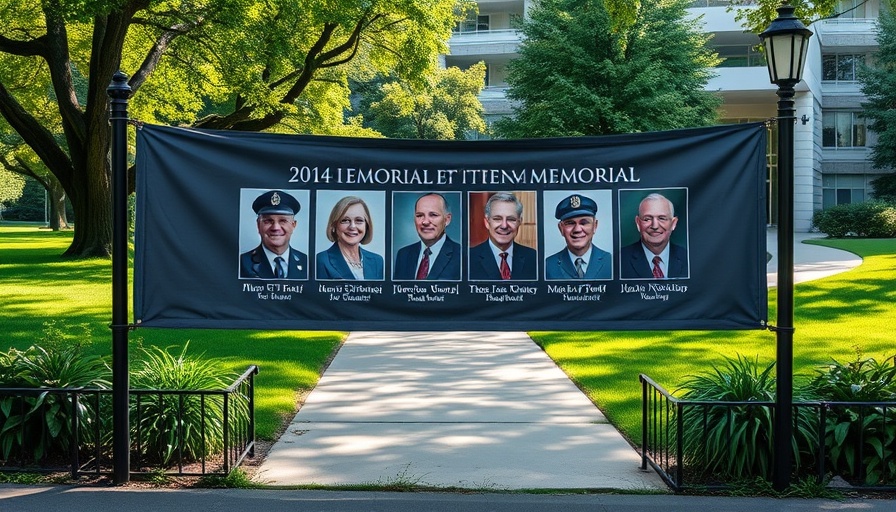
Honoring Lives, Inspiring Change: The Rise Memorial Garden
On a somber Saturday, families, friends, and community members gathered in Kelowna to open the Rise Memorial Garden, a poignant tribute that commemorates the lives of five individuals lost in the tragic crane collapse four years ago. As the sun cast a warm glow over Knowles Heritage Park, an atmosphere of remembrance filled the air.
Patrick Stemmer, Eric Stemmer, Jared Zook, Cailen Vilness, and Brad Zawislak are forever engraved in the hearts of those who knew them. Chris Vilness, Cailen’s father, expressed the profound connection among the families that fueled the creation of this memorial: “We were able to bring each of us together to form a foundation, allowing a level of trust, patience, and acceptance—with one common goal—to build a memorial that would pay tribute to our loved ones.”
A Community United in Grief and Hope
The Rise Memorial Garden embodies not just sorrow but also hope for a safer future in the construction industry. It stands as a reminder of the need for stricter safety regulations to ensure such devastating accidents do not occur again. Speaking at the memorial service, Hermender Singh Kailley of the BC Federation of Labour invoked a call to action for communities, employers, and government officials: “Justice delayed is justice denied.” His fervent wish is for this garden to serve as a catalyst for change, compelling all parties to prioritize worker safety.
Seeking Justice and Accountability
Yet, despite this emotional gathering and the establishment of the memorial, a cloud of uncertainty hangs over the families. The legal aftermath of the collapse has been slow, and many feel the justice they seek is just out of reach. In February 2024, the Kelowna RCMP submitted a report recommending charges of criminal negligence causing death. However, the BC Prosecution Service is still determining the next steps, leaving families in a state of anxious limbo.
Helen Furuya, the widow of Brad Zawislak, articulated the frustrations felt by many, stating, “Four years into this tragedy and still no accountability or significant workplace safety regulation changes.” Her emotional plea was clear: the Rise Memorial Garden should be a place of forgiveness but also of rallying for new laws that prioritize the safety of workers—what she terms "Brad’s Law."
Lessons Learned: A Call for Better Safety Practices
While the landscape of construction safety regulations is evolving, the families have yet to see the comprehensive changes they seek. Currently, WorkSafeBC is incorporating key learnings from the investigation into its safety initiatives, which include training for tower crane operators and rigorous inspections. Nevertheless, the organization has withheld findings pending legal actions, leaving many questions unanswered for the grieving families.
The establishment of the memorial represents more than a tribute; it symbolizes a communal commitment to raising awareness about workplace safety and the urgent need for systemic changes in the industry. Community engagement remains critical, reminding us that every individual deserves to return home safe after a day’s work.
The Emotional Impact: Remembering the Lost
The Rise Memorial Garden serves not only as a physical reminder of the tragedy but also as a space where stories of those lost can continue to be shared and celebrated. As attendees spoke of the lives of the deceased, warmth and camaraderie grew amidst the sorrow, highlighting how their legacies could inspire both personal and communal change.
In the face of such loss, communities have the power to incite a transformation in workplace culture by advocating for essential safety measures. The memorial stands as a somber yet hopeful symbol that conveys the importance of prioritizing human life in all sectors.
Community Solidarity: Making Safety a Priority
As the community rallies around the memorial, the hope is for ongoing support and advocacy surrounding workplace safety legislation. Each visit to the Rise Memorial Garden can serve as a reminder to perpetuate the change that these families hope for—a legacy rooted in safety that grows with every flower planted and visited.
This initiative reflects not only the tragedy's toll but also the incredible strength of community bonds in the wake of disaster. With continued advocacy and collective action, there lies the potential to honor the memories of Patrick, Eric, Jared, Cailen, and Brad by fighting for a future where every worker goes home safely.
Embracing the lessons of the past can chart a more secure and safer tomorrow for all workers. The commitment to "Brad’s Law" and the findings of the WorkSafeBC investigation will hopefully translate into meaningful changes that foster safer environments for everyone involved in construction and beyond.
As you reflect on this article, consider what actions you can take in your own life to advocate for workplace safety. Every voice matters in the push for change that can prevent further tragedies in the community.
 Add Row
Add Row  Add
Add 




Write A Comment